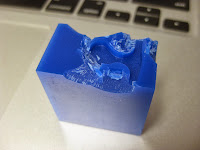- Embedding of optical components (1 mm diameter glass fiber, in this case) into the urethane;
- Comparison of different urethanes, specifically Task 4, 14 and 18.
As it turns out, Task 4 (white) cured well, while the Task 14 (black) and Task 18 (gray) parts did not cure well. I believe that the latter two had problems curing because I did not mix the A/B parts very well. Here are the poured molds:
Some thoughts:
- Task 4 (white) is nice in that the material is slightly translucent, which makes it possible to visually observe the filling of the mold.
- Task 18 (gray) is considerably more viscous than the other two urethanes, which makes pouring into small molds difficult. It may be necessary to utilize a syringe with this material.
Here is the extraction of the Task 4 part:
Note: the fiber placement in the base mold was misaligned. I had some issues with the zero master of the CNC that I am using, which grossly misaligned the fiber in the pocket.
Here's the extraction of the Task 18 part:
Note: the Task 18 part was not properly mixed, and the consequence was that the resulting part was somewhat wet and "soggy." When applying a nontrivial amount of force to remove the part from the mold, I ended up breaking the part into two:
I plan on repeating the pour, taking into account the proper mixing of parts A and B, and fixing the zero master of the CNC so that the fiber can be accurately placed in the mold.


















































